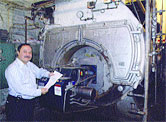 |
 |
|||||
 |
 |
 |
 |
 |
|||
 Deacon Ramon Echevarria, business manager at Our Lady of Tepeyac Parish, has seen the gas bill more than double since May. Catholic New World/Sandy Bertog |
Heating costs have chilling effect on parishes
By Michelle Martin Staff writer When it comes to paying heating bills this winter, archdiocesan officials have some advice for pastors and other parish leaders: pray for a mild winter. That was the last item on a list of more usual recommendations that Finance Director Tom Brennan sent to all pastors: turn down the thermostat, keep doors closed, break down the increased costs to make it appear more manageable to parishioners, share with parishes that have fewer financial resources. But no matter what parishes do, Brennan said, they will have to face huge costs they didn’t anticipate when they planned their budgets early this year. “We’re expecting costs to be 40 to 50 percent higher,” said Brennan. “We’re expecting the extra heating costs to be $6 to $8 million higher this year. That’s not just for parishes, though.” Costs spiked in the aftermath of hurricanes Katrina and Rita, which damaged wellheads and pipelines, but were expected to rise even before the storms because demand has outstripped demand, according to the U.S. Energy Information Agency, Parishes and other archdiocesan institutions all pay lower rates for natural gas than residential users because the archdiocese purchases all its energy in bulk through a contract with Exelon, Brennan said. Buying wholesale rather than retail saves between 10 and 15 percent. An average parish can expect to see heating costs rise about $20,000 this year, he said. But Our Lady of Tepeyac in Little Village is not an average parish. It operates an elementary school and high school, as well as the church, rectory and parish offices, and rents out buildings it is no longer using. Deacon Ramon Echevarria, the parish business manager, got a shock when he opened the November gas bill. It was $11,300, more than double what it was paying each month last spring. Last May, the parish, which is on a plan that tries to even out the gas bills over the course of the year, paid $4,700 in a monthly gas bill. As it became obvious that prices would rise, the bill increased to $5,200 a month in May. Echevarria said he had not paid the September and October bills when he got the one for November. Asked how the parish would pay, he said, “We can’t.” But it will try, he said, by asking outside agencies that rent parish buildings to pay more, and by asking parishioners to donate more. At the same time, the parish has cut the overnight thermostat setting to 55 degrees, which increases to 63 degrees at 7 a.m. “It’s still cold,” he said on a late November day. “But we told everyone to dress warmer, so maybe it will just be their feet that are cold. That’s how I am now.” Of course, he added, the thermostats in the parish elementary and high schools are set higher for the sake of the students, who must wear uniforms. In addition to adding layers of clothing, staff members have been asked to make sure they turn off any equipment not in use—except the coffee pot, which is used nearly constantly, especially with the colder indoor temperatures. “With all this, we’re hoping that at the end of the budget year, we’ll have money coming back to us, or at least break even,” he said. So far, donations have not gone up much. “It’s gone up a little,” Echevarria said of the weekly collection, “but people are suffering the same thing at home.” The only place the parish can cut costs is building maintenance, which will create larger problems in the future. “If we cut more salaries, we might as well start closing our doors,” he said. “But if we don’t do the maintenance, what’s happening is that the buildings are deteriorating more.” Some parishes are better off because they have done work on their buildings to improve energy efficiency, said Greg Veith, manager of the archdiocese’s Department of Facilities and Construction. Since 1999, parishes have put between $15 million and $20 million into projects from replacing windows and putting in tighter-fitting doors to installing high-efficiency furnaces and boilers. Many of those changes were made as parishes did more extensive renovation projects with money they raised as part of the “Sharing Christ’s Gifts” Millennium Campaign, and were included with the idea that the energy savings would eventually make them pay for themselves. With higher energy costs, those savings are even higher, Brennan said. Overall, the simple steps the archdiocese has suggested—steps Brennan reiterated to the Archdiocesan Pastoral Council in a meeting Nov. 19—could save parishes 5 to 10 percent. But many churches will always be big energy users, Veith noted. “They’re old, high-volume buildings,” he said, and added that Brennan’s suggestion to pray is a good one. “I always tell people that there’s a higher power protecting these buildings,” Veith said, “because in most cases, we’re not doing it.” |
||
|
|
|||